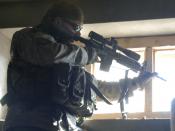War can destroy a man both in body and mind for the rest of his life. In "The Sniper," Liam O'Flaherty suggests the horror of war not only by presenting its physical dangers, but also by showing its psychological effects. We are left to wonder which has the longer lasting effect-the visible physical scars or the ones on the inside? In this story the author shows how location plays a big part in how physically dangerous a war is. Gunshots heard throughout the city are a sign of how close the fighting between the "Republicans and Free Statersâ¦" is to innocent citizens (this is most often the case in civil war). The sniper's positioning "on a rooftop near O'Connell Bridge" is very dangerous, for he can see everyone who enters the town, but they cannot see him. "â¦Machine guns and riflesâ¦" are the weapons of choice in this story; very dangerous, for they are very strong guns that are "true" war weapons.
As evidenced above, location plays a big part in how dangerous a war is.
Bullets, of course, are another big danger in war. The author shows with bullets how close you are to death in a war. In the event where the sniper lights his cigarette, he is twice almost killed with the "enemy" sniper's bullets! The sniper's own bullets are quite dangerous, too, as seen when he easily kills the tank commander and citizen woman informer. After shooting them, the "enemy" sniper sees him, and "His forearm [is] dead." This is considered lucky as far as war goes, though, for instead of just having a broken arm he could be dead! The sniper brushes with death again when he throws his revolver down without thinking and it goes off. Bullets make a war very deadly,


